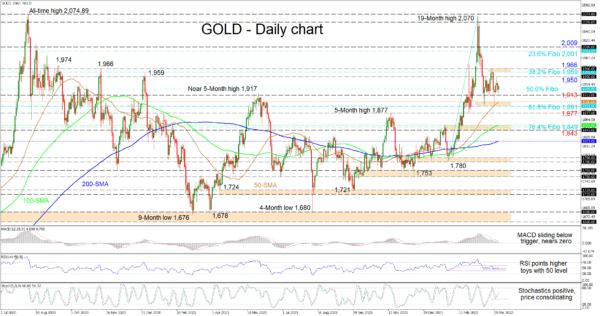Gold has stabilized around the 1,925 level, which is the 50.0% Fibonacci retracement of the near six-week rally from 1,780 until the 19-month high of 2,070. The rising simple moving averages (SMAs) continue to endorse the bullish trend in the commodity.
Meanwhile, the picture painted by the short-term oscillators is one of conflicting signals in directional momentum. The MACD is indicating that positive momentum continues to wane as it glides beneath its red trigger line towards the zero threshold. Currently, the RSI is fluctuating around the 50 neutral mark failing to provide a convincing price preference in the yellow metal. Lastly, the stochastic oscillator has regained a positive charge and is promoting upside price action.
If the price of the precious metal deteriorates below the immediate 50.0% Fibo, prompt downside friction could occur at the 1,913 level ahead of a crucial support band between the 50-day SMA at 1,900 and the 61.8% Fibo of 1,891. If the 50-day SMA and the 61.8% Fibo fail to defend the positive structure, sellers may then challenge the key 1,877 barrier before targeting the fortified support zone from the 100-day SMA of 1,853 until the 1,843 low.
Alternatively, if buyers fuel extra positive traction from the 50.0% Fibo of 1,925, resistance could originate from the 1,950 nearby high prior to the bulls confronting the resistance zone linking the 38.2% Fibo of 1,959 to the March 24 high of 1,966. Overcoming this barricade may encourage the bulls to pilot higher, in order to tackle the 23.6% Fibo of 2,001 and the neighbouring 2,009 obstacle.
Summarizing, gold is exhibiting a neutral-to-bullish bias above the SMAs, the March 29 trough of 1,890 and the 61.8% Fibonacci level. A climb in the price above the 1,966 barrier could ramp up upside momentum. Yet, for the positive outlook to dampen, the price would need to sink clearly beneath the 1,877 border.












